Republic of Belarus
Belarus's first issue (1992–1994), worth 30, 45, and 50 cents, was put into circulation on 21 December 1992. In 1993, it was additionally issued stamps in 1, 2, 3, 5, 10, 15, and 25 rubles with the date "1992" and the 50, 100, and 150 rubles, with the date "1993" in the 1994 stamps were issued in 200, 300, 600, 1000 and 3000 rubles. The basis of the composition marks the first standard-issue was the national emblem of the sample 19 September 1991. The following are known overprints on stamps of the first standard production: overprint new face on stamps in 1992 (in 1994 and 1997.) And overlay the denomination ("A" and "B"), made in 1996.
In connection with the national emblem change, in 1995, it was carried out of the second issue of stamps Standard Edition par 180, 280, and 600 rubles, which was replaced by the coat of arms of view Victory Square in Minsk. In 1996 he was also released an additional mark of this release is 200 rubles (dated 1995). The 2001 edition marks the second part of the standard-issue was overprinted new value (1000 rubles).
Stamps third standard issue with the image of the sample 14 May 1995's emblem was issued in 1996–1997. In 1996 were produced in the mark 100, 200, 500, 600, 1000, 1500, 1800, 2200, 3300, 5000, 10.000, 30.000 and 50.000 RR. In 1997, the issue of stamps was carried out (with the date 1996), and 2000 worth 400 rubles and the mark of 1,500 rubles (also with the date 1996) was released in the changed color (blue instead of pink.) Later stamps were issued in this issue worth 800, 2,500, and 3,000 rubles, with the date "1997." The 2001 edition marks the second part of the standard-issue was overprinted new value (400 rubles).
Mark of the fourth standard issue was issued from 1998 to 2003. The main motive of the series was "ethnographic subjects." Often, due to inflation, the plot marks a nominal duplicated. Belarus story in the $100 registration in 1998 ("Watermill") was repeated on the mark of 30,000 rubles in the 1999 year. In 1998, the stamps were issued of 100, 200, 500, 1000, 1500, 2000, 3000, 3200, 5000, 5300 and 10,000 rubles. In 1999, Belarus released par 800, 30,000, 50,000, 100,000 and 500,000 rubles. 1 January 2000 years after the denomination in circulation began to enter the fourth-grade standard issue in the new prices scale. In 2000, the stamps were issued in 1, 2, 3, 5, 10, 20, 30, 50, and 100 rubles, and lettering denomination (A and B). In 2001, the stamps were issued in 100, 200, 500 rubles, and the overlay of the new face (1000 rubles) on the mark of $100 in 1998. In 2002 Belarus re-released in 1, 2, 3, 5, 10, 20, 30, 50 rubles and lettered denomination (A and B). In 2003 Belarus re-released in 200 and 500 rubles.
Mark, the fifth standard issue, was issued from 2002 to 2007. The main motive was the image of landmarks (except the 1000-ruble mark, which depicted a personal coat of arms Skarina). In 2002, the face value of stamps was issued in 1000, 2000, 3000, 5000 rubles and lettered with the nominal value image (H, C). In 2006, the mark of 3,000 rubles was reissued with a changed pattern in the new color. In 2007 Belarus re-released 2000 rubles.
Sixth Standard Edition ("flowers," square format) was implemented in 2002 and represented Belarus' stamps in 200, 500 rubles, and the denomination of the lettered (A, B, C, D).
Stamps seventh standard issue with the image of berries was issued in 2004. The series was presented brands in 5, 10, 20, 30, 50, 100, 200, 300, 500, 1,000 rubles and lettered nominal value designation (A, B, C, N, P).
Also, in 2004, have been released and marks the eighth standard issue ("wild trees"), presented in denominations of 100, 200, 300, 400, 500, and 1000 rubles, and the denomination of the lettered (A, B, C, H, P ).
In 2006, the standard was implemented ninth edition ("Bird"), submitted to the marks of 10, 20, 30, 50, 100, 200, 300, 500, 1,000 rubles and lettered designation of nominal value (A, B, and H).
In 2007, the stamps were issued tenth standard issue ("beasts," the format of the diamond) with lettering denomination (A and B). Each brand was introduced in two design options.
The same theme was repeated in the eleventh grades Standard Edition (2008), presented in denominations of 10, 200, 300, 400, 1,000, and 5,000 rubles. In contrast to the 2007 edition of the brand in 2008 was the "book" format.
Also, in 2008 was conducted emission marks the twelfth standard issue ("flowers," "book" format) with face value 20, 30, 50, 100, 500 rubles, and the denomination of the lettered (A, B and H).
In January 2012, has been implemented emission standard marks the thirteenth issue ("national pattern") with lettering denomination (M and N). In March 2012, the sales will go mark the fourteenth Standard Edition ("monuments"), par 50, 100, 200, 500, 1,000, 2,000, 5,000, 10,000, 20,000 rubles and lettered designation of nominal value (A, H and P). The first release of these brands is different from the re-issue of their (second half of 2012 – the beginning of 2013), the type used in the paper they are printed.
Currently (2012), for frank postings are valid the following standard grades of Belarus: brand first standard-issue overprinted a literal face value (A and B, 1996), marks a second standard-issue overprinted new value (1000 rubles, 2001 ), marks the third standard-issue overprinted new value (400 rubles, 2001), as well as the brand of the fourth and subsequent editions issued after 2000 (including $100 in 1998 with an overprint of new value, implemented in 2001 g) except for grades of 1, 2, 3 and 5 rubles.
In February 2019, four commemorative stamps were released for the 2019 European Games, to be held in Minsk in June that year. [2] [3]
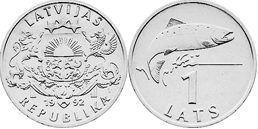
The Latvian lats was the currency of Latvia from 1922 until 1940 and from 1993 until it was replaced by the euro on 1 January 2014. A two-week transition period during which the lats was in circulation alongside the euro ended on 14 January 2014. The lats is abbreviated as Ls and was subdivided into 100 santīmi, abbreviated as an s after the santīm amount.
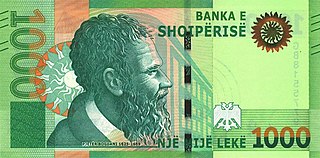
The lek is the currency of Albania. Historically, it was subdivided into 100 qintars.

The lev is the currency of Bulgaria. In old Bulgarian, the word "lev" meant "lion"; the word "lion" in the modern language is lаv. The lev is divided in 100 stotinki. Stotinka in Bulgarian means "a hundredth" and in fact is a translation of the French term "centime." Grammatically, the word "stotinka" comes from the word "sto".

The Bangladeshi taka is the currency of the People's Republic of Bangladesh. In Unicode, it is encoded at U+09F3৳BENGALI RUPEE SIGN.

Banknotes of the Philippine peso are issued by the Bangko Sentral ng Pilipinas for circulation in the Philippines. The smallest amount of legal tender in wide circulation is ₱20 and the largest is ₱1000. The front side of each banknote features prominent people along with buildings, and events in the country's history while the reverse side depicts landmarks and animals.
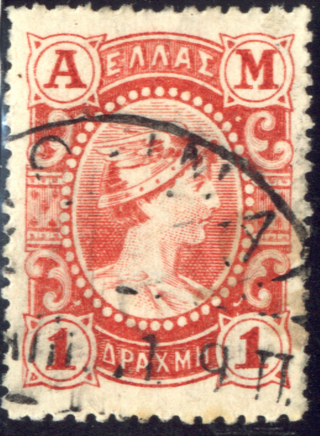
Greece's first postal service was founded in 1828, at the time of Greek independence from the Ottoman Empire. This initial service continued mail delivery and, later, the issuing of postage stamps until 1970. It was then succeeded by the Hellenic Post S.A., which remains Greece's official postal provider. The first Greek stamps were issued in 1861; by then, the postal service had expanded to operate 97 branches.

The Transnistrian ruble is the currency of the internationally unrecognized state of Transnistria. It is divided into 100 kopecks.

The karbovanets or karbovanet, also known as kupon or coupon, has been a distinct unit of currency in Ukraine during three separate periods of the 20th century. It is also a predecessor currency of today's Ukrainian hryvnia.
The postal history of Northern Epirus, a region in the western Balkans, in southern modern Albania, comprises two periods; 1912–1916 and 1940-41. Northern Epirus was under Greek administration during the First Balkan War (1912–1913), but it was then awarded to the newly founded Albanian state by the Florence Protocol (1913). During this period, Greek stamps were used. Greece withdrew from the region in early 1914. The people of Epirus were unwilling to be part of Albania, though, and launched a revolution. Under a provisional government, the independent Northern Epirus was formed in February 1914 and it eventually managed to gain full autonomy under nominal Albanian sovereignty, according to the Protocol of Corfu. Northern Epirus operated its own postal service and issued postage stamps, both official and unofficial, during that year.

The ruble, rouble or rubel is the currency of Belarus. It is subdivided into 100 kopecks.
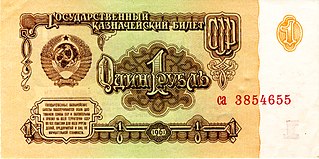
The ruble or rouble was the currency of the Soviet Union. It was introduced in 1922 and replaced the Imperial Russian ruble. One ruble was divided into 100 kopecks. Soviet banknotes and coins were produced by the Federal State Unitary Enterprise in Moscow and Leningrad.

The real was the unit of currency of Portugal and the Portuguese Empire from around 1430 until 1911. It replaced the dinheiro at the rate of 1 real = 840 dinheiros and was itself replaced by the escudo at a rate of 1 escudo = 1000 réis. The escudo was further replaced by the euro at a rate of 1 euro = 200.482 escudos in 2002.

The ruble or rouble is the currency unit of Belarus and Russia. Historically, it was the name of the currency of the Russian Empire and, later, of the Soviet Union.
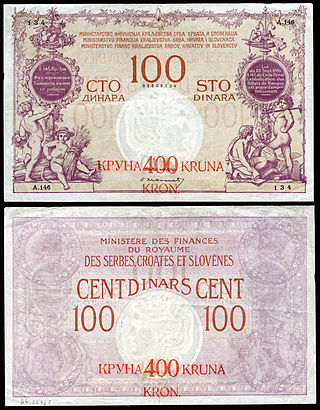
The krone was a short-lived, provisional currency used in parts of the then newly formed Kingdom of Serbs, Croats, and Slovenes, parts of which had previously been part of the Austro-Hungarian Empire (Austria-Hungary). It was worth 1⁄4 of a dinar or 25 para and subdivided into one hundred hellers. The name translates into English as crown.

Numerous Chinese stamps depict Sun Yat-sen, and a representative collection can be acquired with little trouble. These may conveniently be divided as the definitives, provincial issues, overprints, and commemoratives, but there is much crossover between these categories.
The franc was the currency of Réunion until 1999. Before 1975, Réunion had its own franc, distinct from that of France. After 1975, the French franc circulated. Réunion now uses the euro. The Réunion franc was subdivided into 100 centimes.
The 10 Polish Złotych note is the lowest value złoty banknote and has been used since the redenomination of the złoty in 1995. The note is used as the sole currency in Poland, a country with a population of about 38 million.

The first official currency of Brazil was the real, with the symbol Rs$. As the currency of the Portuguese empire, it was in use in Brazil from the earliest days of the colonial period, and remained in use until 1942, when it was replaced by the cruzeiro.
The National Bank of Ukraine has issued four banknote series since 1996. All banknotes in denominations of ₴1, ₴2, ₴5, ₴10, ₴20, ₴50, ₴100, ₴200, ₴500 and ₴1,000 issued after 2003 are considered legal tender. All of them depict an important person in Ukraine's history on the obverse and a landmark place on the reverse. The lowest four denominations are no longer issued in banknotes and are intended to be gradually substituted by coins, though they remain common. There have been four commemorative banknote issues.

Revenue stamps of China were first prepared for issue by the Qing dynasty in the late 19th century, but the first revenue stamps which were in general use were issued by the Republic of China after the 1911 revolution. A wide variety of revenue stamps have since been issued, including numerous provincial and local issues.
















